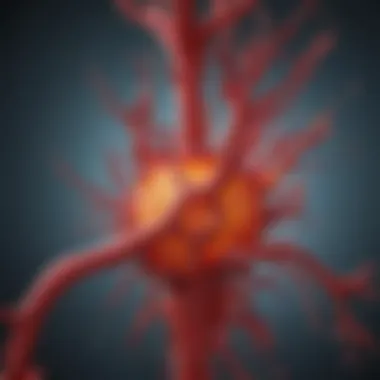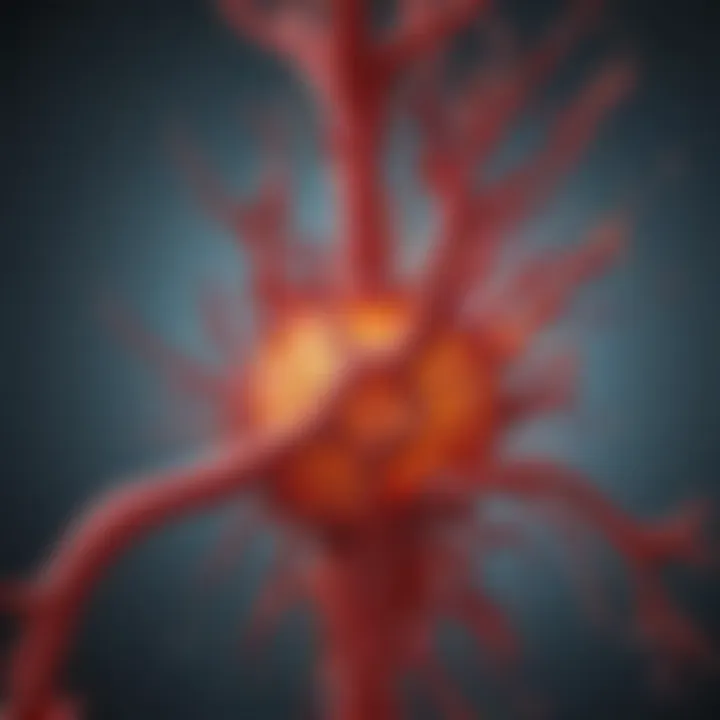Understanding Oxidative Stress and Inflammation


Intro
Oxidative stress and inflammation are two fundamental biological phenomena that are interconnected in complex ways. They serve critical roles in various physiological and pathological processes. Understanding the interplay between these two mechanisms is essential for gaining insights into a wide range of diseases, including chronic conditions and age-related disorders.
Research Overview
Summary of Key Findings
Research indicates that oxidative stress results from the imbalance between reactive oxygen species (ROS) production and the body’s ability to eliminate them. This condition can trigger inflammation, which is primarily a defense mechanism. However, chronic inflammation can, in turn, exacerbate oxidative stress, creating a detrimental cycle that contributes to the pathophysiology of many diseases.
Background and Context
The importance of this interplay has gained attention in recent years, particularly in the context of conditions such as cardiovascular diseases, diabetes, and neurodegenerative disorders. Each of these conditions demonstrates how oxidative stress and inflammation are not only linked but also pivotal in disease onset and progression. Understanding their relationship can inform preventative strategies and therapeutic interventions.
Methodology
Experimental Design
To explore the relationship between oxidative stress and inflammation, researchers often employ both in vitro and in vivo methodologies. In vitro studies typically involve cell cultures exposed to various stressors to evaluate the response of inflammatory markers and oxidative damage. In vivo studies usually involve animal models to assess how these phenomena interact within a whole organism.
Data Collection Techniques
Data collection typically includes measures of oxidative markers through assays that quantify levels of lipid peroxidation, protein oxidation, and DNA damage. Inflammation is assessed through the measurement of cytokines and other inflammatory mediators using techniques like ELISA or PCR. This data allows for a comprehensive analysis of how oxidative stress influences inflammatory pathways and vice versa.
"Chronic oxidative stress and inflammation can drive the progression of many degenerative diseases, making understanding their interplay critical for effective interventions."
The findings from these methodologies contribute to a deeper understanding of the mechanisms that underpin the relationship between oxidative stress and inflammation, providing avenues for future research and therapeutic development.
Preface to Oxidative Stress and Inflammation
Oxidative stress and inflammation are fundamental biological phenomena that profoundly impact human health. These processes are interlinked and contribute to various diseases, including neurodegenerative disorders, cardiovascular diseases, and metabolic syndromes. Understanding the dynamics of oxidative stress and inflammation is critical for both research and clinical applications.
Oxidative stress arises when there is an imbalance between reactive oxygen species (ROS) production and the body’s ability to detoxify these harmful substances. Inflammation, on the other hand, is an essential immune response that can become chronic under certain conditions. While inflammation is a natural defense mechanism, persistent inflammation can lead to tissue damage and disease.
The study of oxidative stress and inflammation is significant due to the multitude of health implications. It not only helps in elucidating the pathogenesis of diseases but also opens avenues for therapeutic interventions that target these processes. By investigating how oxidative stress and inflammation interact, researchers can identify potential biomarkers for diseases and develop novel treatments that could mitigate their harmful effects.
In this article, we will explore the definitions, mechanisms, and implications of oxidative stress and inflammation. The goal is to provide a comprehensive overview that underscores the importance of understanding their relationship and encourages further research in this crucial area of health science.
Mechanisms of Oxidative Stress
The mechanisms of oxidative stress play a crucial role in understanding its impact on human health. Oxidative stress occurs when there is an imbalance between reactive oxygen species (ROS) production and the body's ability to counteract their harmful effects. This imbalance can lead to damage in various biological structures, contributing to the progression of diseases such as cancer, cardiovascular diseases, and neurodegenerative disorders. An exploration of the sources of reactive oxygen species, as well as their cellular impacts, offers valuable insights into the consequences of oxidative stress.
Sources of Reactive Oxygen Species
Internal Sources
Internal sources of reactive oxygen species are primarily generated from normal cellular metabolism. The mitochondria, responsible for energy production, are the main contributors to these internal ROS. During aerobic respiration, electrons can leak from the electron transport chain, leading to the formation of superoxide anions, which can then contribute to further oxidative damage. This process is intrinsic to cellular functions, making it a common and important aspect to consider in this article. In essence, internal sources are inevitable as they are part of the metabolic activity that sustains life. However, excessive ROS production through dysfunctional metabolic processes can pose risks.
The key characteristic of internal sources is their connection to everyday physiological processes. Their contribution is not only central to energy production but also to the signaling pathways involved in cellular defense mechanisms. The unique feature here is that while internal sources are vital, they can also initiate a cascade of oxidative damage when their regulation fails, thus posing disadvantages in a pathophysiological context.
External Sources
External sources of reactive oxygen species include environmental elements such as pollution, ultraviolet radiation, and certain chemicals. These external factors can lead to the generation of ROS when they interact with biological tissues. For example, exposure to UV rays can result in the production of ROS, causing skin damage and increasing the risk of skin cancers. The significance of external sources lies in their ability to exacerbate oxidative stress situations, particularly in individuals with compromised antioxidant defenses.
The key characteristic of external sources is their variability and control; they depend on environmental conditions and lifestyle choices. This article highlights them as critical contributors to oxidative stress, especially in the context of urban living or inadequate protective measures. The unique feature of external sources is that while some exposure can be avoided, many are unavoidable components of modern life, thus presenting challenges in managing oxidative stress effectively.


Cellular Impact of Oxidative Stress
The cellular impact of oxidative stress is profound, affecting various macromolecules within cells, including lipids, proteins, and DNA. Understanding these effects is essential for discerning the implications of oxidative stress on health and disease.
Effects on Lipids
Oxidative stress can significantly affect lipids, particularly polyunsaturated fatty acids found in cellular membranes. When lipids undergo oxidation, it results in lipid peroxidation, leading to compromised membrane integrity. Such alterations in lipids are important because they can affect cell signaling and overall cellular function. The significance of lipid damage in this context lies in its potential to trigger inflammatory responses and cellular apoptosis, which can further propagate disease processes.
The key characteristic of lipid peroxidation is its ability to affect membrane fluidity and permeability. This is a beneficial focus for this article as it highlights a direct consequence of oxidative stress. The unique feature of effects on lipids includes the production of reactive aldehydes, which not only cause further cellular damage but can also lead to the formation of adducts with proteins and nucleic acids, complicating cellular responses.
Effects on Proteins
Oxidative stress also damages proteins through oxidation, resulting in altered protein structure and function. This phenomenon can influence important pathways such as those involved in metabolism, signaling, and immune response. The oxidative modification of proteins can lead to loss of enzymatic function or aberrant signaling, contributing to disease progression.
The key characteristic of protein oxidation is its irreversible nature. In contexts of prolonged oxidative stress, damaged proteins accumulate, leading to cellular dysfunction. This aspect is crucial to highlight in this article as it shows a clear link between oxidative stress and various degenerative diseases. The unique factor regarding protein impact is the potential for misfolding, which may result in the formation of aggregates, often seen in neurodegenerative disorders like Alzheimer’s.
Effects on DNA
Finally, oxidative stress bears significant implications for DNA integrity. ROS can cause various types of DNA damage, including strand breaks and base modifications. Such damage is critical, as it can lead to mutations, genomic instability, or even cancer initiation. The impact of oxidative stress on DNA is potent and far-reaching, meriting careful consideration in discussions about health and disease.
The key characteristic of DNA damage due to oxidative stress is its potential to alter genetic information. This aspect is especially relevant for the article as it draws connections between oxidative stress, cellular aging, and malignant transformations. The unique feature of DNA effects involves repair mechanisms, which may fail under overwhelming oxidative conditions, allowing the detrimental consequences of oxidative stress to accumulate.
Mechanisms of Inflammation
Understanding the mechanisms of inflammation is crucial for grasping how the body reacts to harm and the ways it can lead to disease. Inflammation is both a protective response and a potential cause of chronic health issues. By distinguishing between different phases and types of inflammation, it becomes apparent how these processes interact with oxidative stress. This understanding also informs potential therapeutic approaches aimed at mitigating the negative effects of prolonged inflammation.
Phases of Inflammatory Response
The inflammatory response can be divided into two primary phases: acute and chronic. Each phase plays a distinct role in inflammation and has unique characteristics.
Acute Inflammation
Acute inflammation serves as the body's immediate response to injury or infection. The key characteristic of acute inflammation is its rapid onset and resolution. This response is vital, as it helps to control infections and initiate healing.
One unique feature of acute inflammation is the process of vasodilation. Blood vessels expand, increasing blood flow to the affected area, which brings immune cells to fight pathogens. This is a beneficial aspect because it ensures that crucial immune components reach the site of injury quickly.
However, acute inflammation, if excessive or prolonged, can become harmful. The excessive immune response can also lead to collateral damage in healthy tissues. Therefore, while acute inflammation is beneficial in the short term, it requires careful regulation to avoid potential disadvantages.
Chronic Inflammation
Chronic inflammation, in contrast, can last for months or even years. It is typically characterized by persistent immune activation and a different set of immune cells compared to acute inflammation. This type of inflammation often arises when the body does not clear an invader or when there is ongoing tissue damage.
The unique feature of chronic inflammation is its insidious nature, often developing without noticeable symptoms. This can lead to various diseases, such as autoimmune conditions, heart disease, and even cancer. The prolonged immune activation in chronic inflammation is a significant aspect because it often causes more harm than good.
Given its widespread implications for health, understanding chronic inflammation is essential for addressing many diseases. The negative effects of chronic inflammation may present various treatment opportunities but also pose significant challenges for individuals affected by it, making it a priority in medical research and public health.
Role of Immune Cells in Inflammation
Immune cells play a pivotal role in mediating the inflammatory response. Different types of immune cells contribute distinct functions.
Macrophages
Macrophages are essential players in the inflammatory response. They act as the first line of defense against pathogens and play a role in both acute and chronic inflammation. Their key characteristic is their ability to engulf and digest cellular debris, pathogens, and dead cells.
This unique feature of macrophages makes them invaluable, as they also produce cytokines to attract other immune cells to the site of inflammation. However, an overactive macrophage response can fuel chronic inflammation, creating a cycle of damage.
T Cells


T Cells are critical in adaptive immunity and are involved in the inflammatory response. They can recognize specific antigens presented by other cells and mount an effective immune response. The key characteristic of T Cells is their ability to differentiate into various subtypes, such as helper T cells and cytotoxic T cells.
They are a beneficial choice for the article as they highlight how the immune system tailors responses to specific threats. However, dysregulation of T Cell activity can lead to autoimmune diseases, where the body attacks its own tissues. This complexity adds depth to our understanding of inflammation.
B Cells
B Cells primarily produce antibodies, playing a central role in adaptive immunity. Their key characteristic is the generation of highly specific antibodies that target pathogens. This specificity is crucial for effective immune responses and long-lasting immunity.
The unique feature of B Cells is their ability to remember past infections, allowing for a quicker response upon re-exposure to pathogens. This characteristic benefits the article by showing how adaptive immunity contributes to the inflammatory response. However, B Cells can also contribute to inflammatory damage in the case of producing autoantibodies in autoimmune diseases.
In summary, the mechanisms of inflammation reveal the complexity and significance of this response in the body. Understanding these mechanisms is vital for exploring how oxidative stress interacts with inflammation and the implications for health.
The Relationship Between Oxidative Stress and Inflammation
Understanding the relationship between oxidative stress and inflammation is crucial in the field of health sciences. Both of these biological phenomena play significant roles in various diseases, making their interplay a focal point for further research. The dynamic nature of oxidative stress and inflammation can result in a cycle that exacerbates health issues. For instance, oxidative stress can lead to inflammation, while chronic inflammation can contribute to increased oxidative stress. Recognizing this relationship can aid in developing targeted treatments and interventions to mitigate adverse health impacts.
Shared Pathways and Mechanisms
The interplay between oxidative stress and inflammation is mediated by several shared pathways and mechanisms. Reactive oxygen species (ROS) generated during oxidative stress can activate signaling pathways that trigger inflammatory responses. For example, oxidative stress-induced activation of the nuclear factor kappa-light-chain-enhancer of activated B cells (NF-κB) pathway leads to the production of pro-inflammatory cytokines. This cascade can create an environment conducive to chronic inflammation, which contributes further to oxidative damage.
Moreover, certain enzymes, such as cyclooxygenase, are influenced by oxidative stress levels. They play a pivotal role in converting fatty acids into inflammatory mediators. This demonstrates how oxidative stress can amplify inflammatory responses, leading to a feedback loop that intensifies both phenomena. Understanding these shared pathways helps in identifying potential therapeutic targets for intervention.
The Role of Cytokines
Cytokines, small signaling proteins produced by immune cells, are key players in the relationship between oxidative stress and inflammation. In response to oxidative stress, cells may release cytokines that initiate and propagate inflammation. For example, plasma levels of tumor necrosis factor-alpha (TNF-α) and interleukin-6 (IL-6) often rise during oxidative stress situations, signaling the body to mount an inflammatory response.
However, while cytokines serve protective roles in the immune response, their sustained elevation can lead to pathological conditions. Chronic inflammation fueled by cytokines may contribute to various diseases, including autoimmune disorders and metabolic syndrome. Thus, managing cytokine levels might offer avenues for therapeutic strategies aimed at reducing both oxidative stress and inflammation.
The complex interplay of oxidative stress and inflammation highlights the need for integrative approaches in medical research and treatment strategies. Understanding this relationship can pave the way for novel therapeutic interventions.
Implications for Health
Understanding the implications of oxidative stress and inflammation is crucial in health sciences. These processes are intricately tied to a variety of diseases, influencing both the onset and progression of health conditions. Exploring this connection provides insights into potential prevention and treatment strategies, shaping the future of therapeutic interventions.
Oxidative Stress and Disease
Cardiovascular Diseases
Oxidative stress plays a significant role in cardiovascular diseases. It contributes to the development of atherosclerosis, a condition where arteries narrow due to plaque buildup. The key characteristic of cardiovascular diseases is the impairment of blood flow, which can lead to heart attacks or strokes. This topic is especially relevant because cardiovascular diseases remain one of the leading causes of death globally. The unique feature of cardiovascular disease is its multifactorial nature; lifestyle choices, genetic factors, and environmental influences all intertwine with oxidative stress. Understanding these relationships allows for targeted interventions but also requires a comprehensive approach considering all contributing factors.
Neurodegenerative Disorders
Neurodegenerative disorders, such as Alzheimer's and Parkinson's disease, demonstrate a clear connection to oxidative stress. The brain is particularly vulnerable to oxidative damage due to its high oxygen consumption and lipid-rich composition. The key characteristic of these disorders is progressive neuronal loss, leading to cognitive decline and motor dysfunction. This choice is beneficial for the article as it highlights the chronic nature of these conditions, wherein oxidative stress exacerbates inflammation in the brain. A unique aspect is how oxidative stress can interrupt normal neuronal function, leading to cell death. This dual impact has both advantages and disadvantages; it provides a clear target for potential therapies but complicates treatment due to the multifaceted nature of these conditions.
Diabetes
Diabetes is another critical area impacted by oxidative stress. In diabetes, oxidative stress disrupts insulin signaling and contributes to complications like neuropathy and retinopathy. The key characteristic of diabetes is insulin resistance or inadequate insulin production. This relationship makes diabetes a relevant choice for discussing oxidative stress, as managing this condition requires understanding its biological underpinnings. A unique feature here is the cyclical nature of oxidative stress and inflammation in diabetes management. While there are potential benefits in targeting oxidative stress to improve insulin sensitivity, this approach needs careful consideration due to possible side effects of treatments.
Inflammation and Disease
Autoimmune Conditions
Autoimmune conditions occur when the immune system mistakenly attacks healthy cells. Oxidative stress is significant in these diseases, amplifying the inflammatory response. The key characteristic of autoimmune disorders is chronic inflammation, which can cause tissue damage over time. Featuring this in the article is beneficial as it illustrates the complex interplay between oxidative stress and immune function. A unique aspect is the variability in autoimmune diseases, which can manifest differently in individuals. Targeting oxidative stress could potentially lead to better management but presents challenges due to the unpredictable nature of the immune response.
Chronic Inflammatory Diseases


Chronic inflammatory diseases, such as rheumatoid arthritis and inflammatory bowel disease, are closely related to oxidative stress. The key characteristic here is persistent inflammation, which escalates tissue damage and leads to further complications. Discussing these diseases is vital for the article as they exemplify the long-term consequences of unchecked inflammation and oxidative stress. A unique feature of chronic inflammatory diseases is the impact they have on one's quality of life. Treatment options may mitigate symptoms, but understanding the underlying mechanisms of oxidative stress and inflammation is crucial for developing more effective interventions.
Therapeutic Approaches
Therapeutic approaches addressing oxidative stress and inflammation are gaining attention in the medical field. The complexity of these two interrelated processes necessitates diverse strategies. The importance of these approaches lies in their potential to mitigate the adverse effects of oxidative stress and the inflammatory response. Understanding these treatments can lead to improved outcomes in various health conditions.
Antioxidants as Therapeutics
Natural Antioxidants
Natural antioxidants, such as vitamins C and E, play a crucial role in combating oxidative stress. These compounds are abundant in fruits, vegetables, and nuts. Their ability to neutralize free radicals is a key characteristic that benefits health. The consumption of natural antioxidants is associated with a lower risk of chronic diseases. A unique feature of natural antioxidants is their bioavailability, making them an accessible choice for many individuals. However, while they are generally safe, overconsumption may lead to adverse effects or interactions with medications.
Synthetic Antioxidants
Synthetic antioxidants, like butylated hydroxyanisole (BHA) and butylated hydroxytoluene (BHT), are designed to provide similar benefits as their natural counterparts. They often show higher stability and efficacy in specific situations. A key characteristic of synthetic antioxidants is their targeted action, which can be advantageous in clinical settings. The unique feature of synthetic antioxidants is their ability to be produced in controlled environments, ensuring purity and effectiveness. However, there are concerns regarding potential toxicity and long-term effects, which warrant caution in their use.
Anti-inflammatory Treatments
Non-Steroidal Anti-Inflammatory Drugs (NSAIDs)
NSAIDs, such as ibuprofen and naproxen, are common anti-inflammatory medications. They are frequently used to relieve pain and reduce inflammation. A primary benefit of NSAIDs is their ability to inhibit cyclooxygenase enzymes, reducing the synthesis of pro-inflammatory cytokines. This makes them a popular choice for managing various inflammatory conditions. However, prolonged use can lead to gastrointestinal issues and cardiovascular risks. It is important for patients to be aware of potential side effects and to use these drugs as directed.
Corticosteroids
Corticosteroids, like prednisone, are powerful anti-inflammatory medications. They work by mimicking natural hormones produced by the adrenal glands, regulating immune responses. The main advantage of corticosteroids is their potent anti-inflammatory effects, making them effective for conditions like asthma and autoimmune diseases. A unique feature of corticosteroids is their ability to be administered in various forms, including inhalers, pills, or injections. However, long-term use can lead to significant side effects, such as increased risk of infections and bone density loss, necessitating careful management.
Integrative Approaches
Integrative approaches combine conventional medical treatments with complementary therapies. This can involve lifestyle modifications, such as diet and exercise, along with herbal remedies and supplements. These approaches acknowledge the interplay between oxidative stress and inflammation, aiming for a holistic impact on health. The integration of various treatments promotes overall well-being and often leads to better patient satisfaction. However, it is crucial to ensure that all components are evidence-based and tailored to individual needs.
Future Directions in Research
The evolution of scientific understanding regarding oxidative stress and inflammation has opened numerous avenues for future exploration. Investing in research in this area holds great significance for potential health benefits and therapeutic enhancements. Future studies aim to further clarify the complex relationship between these phenomena, which could lead to refined strategies for prevention and treatment of various diseases. Critical elements for consideration include the identification of novel biomarkers, and the exploration of synergistic effects involving different oxidative stress and inflammation pathways.
Emerging Therapies Targeting Oxidative Stress
The search for effective therapies aimed at oxidative stress is becoming increasingly critical. Emerging therapies focus on enhancing the body’s natural defenses against oxidative damage. Researchers are examining a range of options, including:
- Natural Antioxidants: Compounds derived from food sources such as vitamins C and E, flavonoids, and polyphenols. These have been shown to mitigate oxidative stress by neutralizing reactive oxygen species.
- Synthetic Antioxidants: Laboratory-designed compounds that aim to perform better than their natural counterparts. For example, idebenone, a synthetic analog of coenzyme Q10, has shown promise in animal models and early clinical trials.
- Gene Therapy: A cutting-edge approach that may enable the introduction of antioxidant enzymes directly into cells vulnerable to oxidative damage, offering a more precise intervention.
These therapies represent an important shift towards personalized medicine, as understanding individual oxidative stress profiles can lead to tailored interventions.
Innovations in Anti-inflammatory Interventions
Innovative strategies to combat inflammation are also on the rise. Researchers explore various approaches to modulate inflammatory responses effectively. Some promising areas of innovation include:
- Biological Agents: These involve targeted therapies that inhibit specific molecules involved in the inflammatory process, such as tumor necrosis factor (TNF) inhibitors used to treat rheumatoid arthritis and other conditions.
- Small Molecule Inhibitors: These are designed to block specific enzymes or pathways pivotal to inflammation, like the use of JAK inhibitors that have shown effectiveness in various autoimmune diseases.
- Nutraceuticals: The role of functional foods and dietary supplements in modulating inflammation is being rigorously studied. Omega-3 fatty acids are a notable example, documented for their capability to reduce inflammatory markers.
In this evolving landscape, understanding the interplay of oxidative stress and inflammation remains essential. The future direction of research may lead to new protocols, enhancing longevity and quality of life for individuals across various demographics.
Epilogue
The examination of oxidative stress and inflammation reveals substantial insights into their significance in biological processes. In this article, we have explored the nuances and complexity of these two intertwined phenomena and their profound implications for health and disease. Understanding their interplay is essential for developing effective therapeutic strategies.
Summary of Key Points
- Oxidative Stress: We highlighted the sources of reactive oxygen species, such as environmental toxins and metabolic processes. The effects of oxidative stress on cellular components, including lipids, proteins, and DNA, underscore its role in disease pathology.
- Inflammation: We differentiated between acute and chronic inflammation. The contribution of immune cells, such as macrophages and T cells, in mediating inflammatory responses was emphasized.
- Relationship: Shared pathways between oxidative stress and inflammation were discussed, particularly the influence of cytokines in both processes.
- Health Implications: The article addressed how oxidative stress is linked to cardiovascular diseases, neurodegenerative disorders, and diabetes, while also considering the role of inflammation in autoimmune conditions and chronic inflammatory diseases.
- Therapeutic Approaches: We delved into various treatment modalities, including antioxidants and anti-inflammatory medications, as well as integrative approaches that combine multiple strategies.
- Future Research Directions: Noteworthy are the emerging therapies targeting oxidative stress and innovations in anti-inflammatory interventions, which could potentially transform treatment paradigms.
Final Thoughts on Oxidative Stress and Inflammation
The complexity of oxidative stress and inflammation cannot be understated. Both mechanisms are not merely passive occurrence; they actively participate in health and pathology. A holistic understanding is fundamental for improving therapeutic outcomes. The evidence presented suggests that the relationship between oxidative stress and inflammation is critical for progress in medical research. Fostering more studies in this area could lead to groundbreaking discoveries that enhance our ability to prevent and treat a myriad of diseases effectively.
"The interplay between oxidative stress and inflammation is a critical factor in understanding disease mechanisms and developing new therapeutic strategies."







